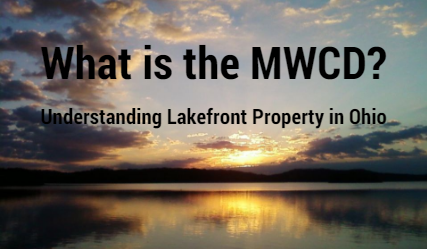
In Ohio there are several types of lakes, it’s a subject covered in our annual seminar but the topic is so important to determining where to buy property that it warrants it’s own series of blog posts. Each type of lake is different with a separate list of pros and cons and every lakefront buyer must know what these differences are before they buy a home, as it can affect the very lakefront lifestyle they want to have. One of these types of lakes in Ohio is called a MWCD lake, or better known as the Muskingum Watershed Conservancy District.
What is the Muskingum Watershed Conservancy District?
Well for starters the Muskingum Watershed is the largest wholly contained watershed in Ohio, it covers about 20% of the state and expands over 8,000 square miles before draining into the Muskingum River. The Muskingum Watershed Conservancy District, or MWCD for short, is a political subdivision of the state of Ohio that is responsible for the maintaining of the series of dams and reservoirs throughout the watershed that offers flood reduction and water conservation, all to the benefit of residents and property owners. There are 10 permanent lakes and 4 reservoirs that the MWCD manage including but not limited to Seneca Lake, Charles Mill, and Pleasant Hill. The important thing for residents and property owners to understand is that the MWCD is a government agency and therefore unlike private lake associations and state parks, the MWCD lakes have their own rules.
The number one thing that potential buyers must understand about buying at a MWCD lake is that in most cases they do not actually purchase the land….that’s right, you buy the house but you technically are classified as a lease and you pay an annual fee to the MWCD for the land that your home sits on. Now there are a select few private areas around some of the lakes where residents do own the land, but for the most part when buying a home the buyer is buying into a long term lease, specifically 30 years or 40 years. These leases have an automatic first right and renewal clause that allows owners to automatically renew the lease if they so choose. Now since the buyer technically does not own the land they only pay taxes on the residence, so the tax break and annual MWCD fee cancel each other out. The MWCD does this so they have better control over what happens around each lake and they have more power to maintain and preserve the land. The agency has strict rules regarding the shoreline and most residents will find out that permanent docks are prohibited and floating docks are the only option, unless they happened to buy in one of these rare privately owned areas.
That being said, since each buyer buys into a long term lease, each buyer is required to attend a mandatory seminar at the MWCD headquarters in New Philadelphia before the property rights are transferred to the new buyer. This way the agency can make sure that the new owner understands all the MWCD rules and regulations. Similar to private lake associations the MWCD does have guidelines for buildings on the property, since they actually own the land, and any action on the land in regards to building needs to be approved beforehand. Residents often forget that they actually don’t own the land and therefore cannot make any decision in regards to building without approval. And on the topic, since the owner is classified as a lease, no property owner can rent out their home. The MWCD does not allow sub-leases and since each owner is already a lease or a glorified “tenant”, you can’t rent the property because that would be a double-lease, or sub-leasing. So a vacation rental business is out of the question.
The last major thing to understand is that the MWCD has some rule about boating that differ slightly from most other lakes. The GREAT NEWS is that at most of the lakes they own, there are no size limitations on boats, and even houseboats are allowed. The MWCD lakes are some of the few places, besides Lake Eerie, where residents can find a place to put an over-sized boat. Even the larger state park lakes don’t allow houseboats because of their relative shallow depths and strict rules. So if you have an extra-large boat and don’t want to go to Eerie, the MWCD may be for you. Now, there is no free swimming in the lake, only from designated beaches or boat-swim areas. And the MWCD has some of the most lax boat rules out there, however horsepower limits vary per lake. Some lakes such as Seneca Lake and Tappan Lake have a 399 HP limit, while Charles Mill is 10 HP and Pleasant Hill has no HP limit. So although some rules cover all lakes, make sure to check with your lakefront specialist about horsepower limits at each individual lake before making a purchase and make sure to talk to them about the specific MWCD rules and make sure that they fit with the lifestyle you’re looking for!
Written by Justin Shelton Lakefront Consultant – The Lake Team
